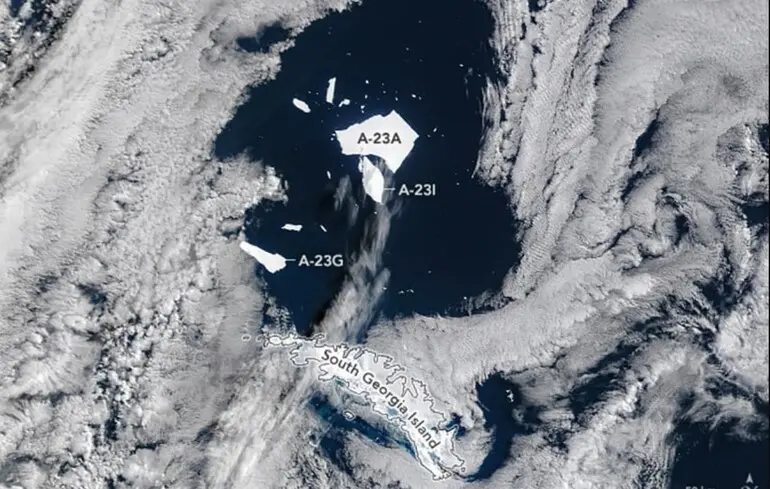World’s Largest Iceberg A-23A Gradually Melts Away: NASA Satellites Capture the Process

The world’s largest ice giant, iceberg A-23A, is nearing the final stages of its existence in the waters of the Southern Ocean.
This remarkable situation was documented through detailed satellite imagery provided by NASA, allowing scientists to observe the slow disintegration of such a massive natural monument, which has an extensive history of stability spanning over three decades.
Originally calved from the Antarctic ice shelf in 1986, iceberg A-23A spent decades drifting across the seas, often stranded on shallow waters and gradually breaking apart under natural forces.
In recent years, the iceberg has begun to move more actively northward, a process monitored closely by NASA satellites.
On September 11, 2025, the Terra satellite equipped with MODIS captured images revealing the ongoing disintegration.
At that point, remnants of the iceberg covered slightly more than 1500 square kilometers, a testament to its once colossal size, as it was the second-largest iceberg in the world.
Over the decades, it lost more than two-thirds of its area since beginning its northbound journey from the Antarctic.
The satellite images also show several large fragments nearby, designated A-23G and A-23I, with sizes of 324 and 344 square kilometers, respectively.
This iceberg’s long history includes detachment from the Filchner Ice Shelf over 25 years ago and remaining on the seabed in the Weddell Sea for most of that time.
Since the early 2020s, it started slowly drifting northward, ultimately leading to its current disintegration.
In March 2024, it entered a powerful oceanic whirlpool in the Drake Passage, and by spring 2025, it was trapped again, this time in shallow coastal ice off South Georgia Island.
Subsequently, it broke free and continued its northward march, likely reaching its end in these waters.
Notably, another massive iceberg, A-83, separated from the Brant Ice Shelf in May 2024 and was also stuck in dense sea ice for a long period.
These phenomena underlie the rapid climatic shifts taking place worldwide, serving as stark reminders that even colossal giants like these are finite and ultimately dependent on the planet’s changing natural systems.

